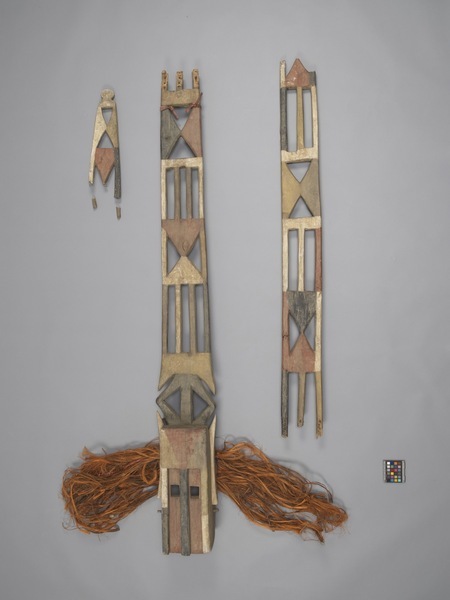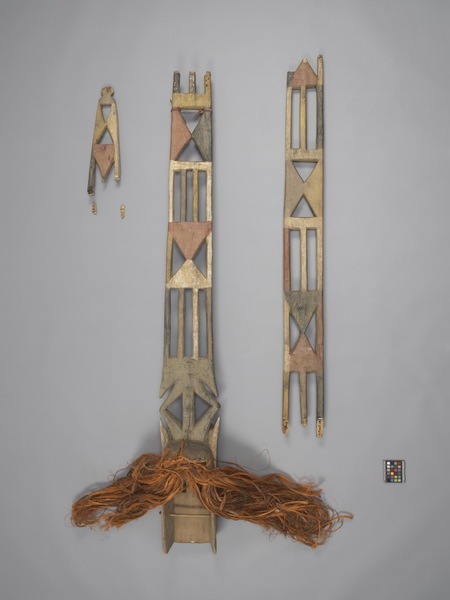Mask Item Number: 3420/23 a-c from the MOA: University of British Columbia


Description
Wood rectangular face mask (part a) with tall ladder-like superstructure with two breaks (parts b-c). The face mask has two sunken rectangular areas on either side of the nose, and two small cutout square eye holes. Inside, there is a wooden bite bar inserted through holes on sides. Ears extend along each side of the face, with small points extending up. Red plant fibre hair is attached to the back of the mask. Extending from the top of the head, between the ears, is a tall superstructure of panels alternating between various hourglass shapes, and lines, tapering in at the end with a sphere at the tip. The superstructure has split, almost in half, through the sixth panel (part b), and again through the eleventh panel (part c) near the top.
History Of Use
In the past, these masks could reach 18 ft high, and were kept in special caves. The sirige mask (meaning 'storied house'̂) is performed in the Sigi ceremony, held every 60 years to honor the ancestors and renew life force, and during the funeral ceremony of a deceased male community member that took part in a Sigi ceremony. Now, like most Dogon masks, they are also used in civic ceremonies and to greet tourists.
Item History
- Made in Mali
- Owned by Richard Tchuemegne before February 5, 2020
- Received from Richard Tchuemegne (Seller), Michael O'Brian Family Foundation (Funding source) and Museum of Anthropology Exhibitions Budget (Funding source) on February 5, 2020
What
- Name
- Mask
- Identification Number
- 3420/23 a-c
- Type of Item
- mask
- Material
- metal, wood, paint and plant fibre
- Part A
- height 226.0 cm, width 24.0 cm, depth 18.0 cm
- Part B
- height 139.5 cm, width 14.0 cm, depth 2.8 cm
- Part C
- height 43.3 cm, width 12.5 cm, depth 2.8 cm
Who
- Culture
- Dogon
- Previous Owner
- Richard Tchuemegne
- Received from
- Richard Tchuemegne (Seller), Michael O'Brian Family Foundation (Funding source) and Museum of Anthropology Exhibitions Budget (Funding source)
Where
- Holding Institution
- MOA: University of British Columbia
- Made in
- Mali
When
- Ownership Date
- before February 5, 2020
- Acquisition Date
- on February 5, 2020
Other
- Condition
- fair
- Accession Number
- 3420/0023